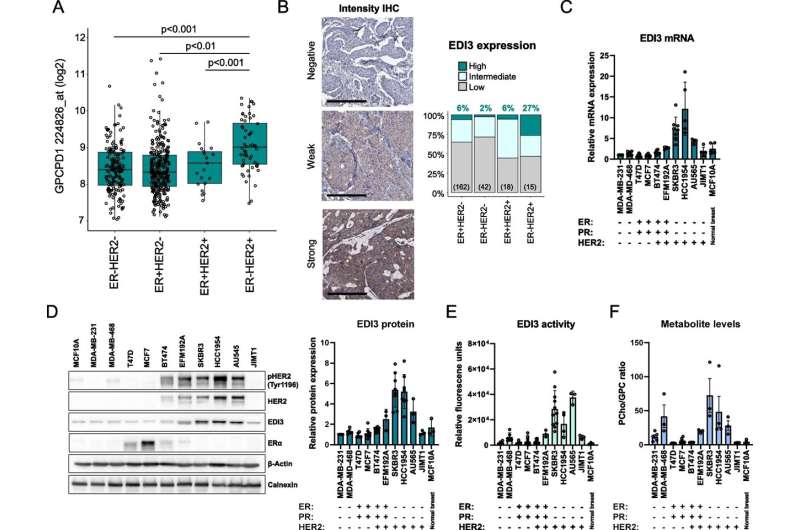This article has been reviewed according to Science X's editorial process and policies. Editors have highlighted the following attributes while ensuring the content's credibility:
fact-checked
proofread
New potential therapeutic approach for HER2-positive breast cancer discovered

Resistance to HER2-targeted therapies can be a problem when treating patients with HER2-positive (HER2+) breast cancer. Therefore, the identification of new therapies for this patient group is important. Researchers at the Leibniz Research Center for Working Environments and Human Factors in Dortmund (IfADo) have already shown that the enzyme EDI3 is associated with changes in the metabolism of cancer cells. Their most recent results reveal that inhibiting EDI3 may be a new therapeutic target in patients with therapy-resistant ER-HER2+ breast cancer.
Tumor cells alter their metabolism in order to maintain growth, thus ensuring their survival. Enzymes regulate metabolism and are therefore viable candidates for targeted cancer therapies. Researchers at IfADo have already identified one such enzyme—EDI3. The glycerophosphodiesterase EDI3, which cleaves glycerophosphocholine to choline and glycerol-3-phosphate, influences choline and phospholipid metabolism and has been linked to cancer-relevant functions in vitro. While the importance of choline metabolism in breast cancer has been studied, the role of EDI3 in this type of cancer has not yet been explored.
Targeting EDI3 as a therapeutic approach in ER-HER2+ breast cancer
In a recent study published in the Journal of Experimental & Clinical Cancer Research, the researchers showed that EDI3 expression is highest in ER-HER2+ breast tumors in humans and that both expression and enzymatic activity were highest in ER-HER2+ breast cancer cell lines. Silencing of HER2 as well as inhibition of HER2 signaling decreased EDI3 expression. Inhibition of EDI3, in turn, primarily reduced the viability of ER-HER2+ cells. Furthermore, inhibition of EDI3 in ER-HER2+ cells resistant to HER2-targeted therapy reduced cell viability in vitro and tumor growth in vivo in mice.
Based on these findings, the researchers conclude that EDI3 expression is upregulated in ER-HER2+ breast cancers compared to other subtypes. Furthermore, inhibiting EDI3 leads to a significant reduction in viability and tumor growth, especially in ER- HER2+ breast cancer cells that are resistant to conventional HER2-targeted therapies. Targeting EDI3 may therefore be a therapeutic approach to enhance the effect of standard therapies, or an alternative in the case of resistance to standard therapies.
Receptor status of the tumor
HER2 is the name of a growth factor receptor. Its task is to take up signals from outside the cell, conduct them into the cell interior, leading to the stimulation of cell division. If a patient has too much of the HER2 growth factor receptor, the tumor is referred to as HER2+—a subtype of breast cancer. As a result of the many growth signals, the tumor can divide uncontrollably. Determining HER2 status is important since there are medications that specifically target HER2. Most HER2+ patients do respond successfully to such medications, but therapy resistance is a problem for some. Therefore, alternative treatments are needed for this tumor subtype.
In addition to HER2 signaling, the hormone estrogen can also affect the growth of breast cancer cells. Estrogen attaches to binding sites (hormone receptors) of the cell, which then turns on expression of genes that favors cell growth. To determine whether a tumor grows in a hormone-dependent manner, the proportion of cells and the amount of the corresponding hormone receptors is often examined. The result is expressed by the indication ER+ (estrogen receptor positive) or ER- (estrogen receptor negative).
More information: Magdalena Keller et al, Inhibiting the glycerophosphodiesterase EDI3 in ER-HER2+ breast cancer cells resistant to HER2-targeted therapy reduces viability and tumour growth, Journal of Experimental & Clinical Cancer Research (2023). DOI: 10.1186/s13046-022-02578-w





















